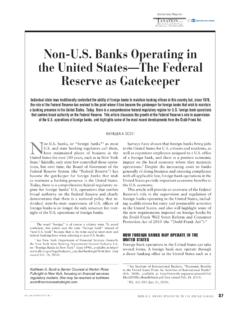Transcription of Lincoln MoneyGuard Reserve — New York
1 Lincoln MoneyGuard Reserve New YorkA smarter alternative to self-insuring Advisor Guide to paying for long-term careLincoln Life & Annuity Company of New YorkNot a depositNot FDIC-insuredMay go down in valueNot insured by any federal government agencyNot guaranteed by any bank or savings associationFOR LIFEU niversal Life Insurance2080150 For agent or broker use only. Not for use with the the need for long-term care preparationLong-term care (LTC) costs are on the rise. LTC expense is a financial risk that could affect clients retirement and wealth transfer goals. Many clients may believe they have saved sufficiently, but in reality, they may not be financially prepared. In a recent survey, 70% of those age 50 and older who chose not to buy protection for long-term care expenses underestimated the cost of care.
2 *ContentsRecognizing the need for ..2 long-term care preparationA smarter alternative .. 5 to self-insuring Product features .. 6 Product benefits .. 6 Long-term care benefits .. 8 Asset leverage examples .. 102* LifePlans Long-Term Care Market Summary; ; Research & Analysis; January 15, 2010. For a printed copy of the report, call 877-ASK- Lincoln . DHHS, 2008. Most recent statistic available on Administration on Aging: 202-619-0724. LifePlans Long-Term Care Market Summary: Cost of Care Update 2010; ; Research & Analysis; October 1, 2010. For a printed copy of the report, call thEsE OthER Lt C FACt s For those age 65+, the average length of long-term care is three years.* the average annual cost of nursing home care is $71,175 for a semiprivate room and $78,840 for a private room. In 2008, 40% of those who received long-term care were between the ages of 18 and 64.
3 *About 70% of people over age 65 will require some long-term care services at some point in their lives. 70%Why should I talk to clients about LtC expense risk?A long-term care experience and its costs can be a tremendous burden on your clients and their loved ones if there is no plan in place. Family members may endure undue stress, as they try to make difficult decisions and identify funds to finance needed care. Preparing ahead can prevent clients and their families from having to make hasty decisions in a time of crisis. Addressing the financial risks creates an awareness of the need to protect their portfolios, including retirement and estate assets, and reserves designated for long-term care. When should I begin bringing up LtC expense risk with my clients?EARLY ANd OFtEN. Those who are most successful in helping clients and their families plan for long-term care bring up the issue multiple times.
4 Clients generally need to have a basic awareness of long-term care either through continued discussion and education or a personal experience. Many decide to protect themselves from the risks of LTC expense after seeing its impact on friends or family. This is why it s important to talk about the risks with clients early and often. Expect that it will take several discussions before clients are ready to take action and prepare for their long-term care indicate that individuals are buying protection for long-term care expenses at younger ages. Clients who purchase protection when they are young and healthy find that it s less expensive. And by adding features like inflation protection, clients can help ensure that they are protected from rising costs over time. tRAdI tIONAL LONg-tERm CARE IN suRANCE COvERs future LTC expenses, but if care is not needed, the client receives no benefits.
5 Premiums can be expensive, may increase, and vary based on benefits and time typically offers coverage or limited coverage only for medically necessary nursing facilities or home healthcare. It does not pay for custodial care or support services for daily living, such as dressing, bathing, and sometimes diabetes monitoring. Clients must meet specific requirements to qualify for Medicare payment of long-term care services. mEdICAId is a government program that can pay for certain nursing home and healthcare services for older individuals with limited means. In many instances, Medicare pays for at-home LTC services, though eligibility and covered services m I LY can assume the burden of long-term care management or expense. This can cause emotional and financial requires clients to set aside potentially significant liquid assets.
6 If long-term care is needed, these assets could be depleted relatively quickly, putting the rest of their portfolio at MoneyGuard Reserve links life insurance and protection for long-term care expenses in one policy, offering a death benefit and a money back guarantee.* It offers tax advantages that other options may not. *Through the Return of Premium Rider on one-time payment policies for ages 30 65. See Rider for complete terms and conditions. It provides tax-advantaged reimbursements for qualified long-term care expenses and more leverage for their LTC dollars. It offers an income tax-free death benefit if all or some of the LTC benefits are not used. It comes with a money back guarantee.*Why clients choose Lincoln MoneyGuard ReserveWhat choices do my clients have when preparing for LtC expenses? 4 Leverage portfolio assetsA smarter alternative to self-insuring Your clients can avoid taking on all the risks of self-insuring.
7 They can use a portion of their cash reserves designated for long-term care to purchase a Lincoln MoneyGuard Reserve policy. They can maintain control of their assets, get much more for their LTC dollars, and enjoy these advantages:Life insurance to create a legacyOtherInvestments/retirement productsCash savings Portion of savingsLong-term care benefits. If the client needs long-term care, the policy can provide income tax-free reimbursements for qualified long-term care income tax-free death benefit. If the client dies, the policy pays an income tax-free death benefit to their beneficiaries. This benefit will be adjusted for any long-term care benefits received. A money back guarantee. The client can request their money back through the Return of Premium Rider.* The amount returned will be adjusted for loans, withdrawals, or benefits paid, and may have tax buying a Lincoln MoneyGuard Reserve policy with a portion of cash reserves.
8 The policy remains an asset in the client portfolio, and it offers:Long-term care benefits Income tax-free reimbursements for qualified long-term care expenses Money back guarantee*ORORD eath benefit Income tax-free legacy for your beneficiaries Premium*Through the Return of Premium Rider on one-time payment policies for ages 30 65. See Rider for complete terms and conditions. Beneficiaries receive an income tax-free death benefit under IRC Section 101(a)(1). Long-term care reimbursements are generally income tax-free under IRC Section 104(a)(3).1 Immediately increase the protection for the rest of the up other portfolio reserves to seek additional a new asset in the portfolio the policy. 5 Product featuresPolicy design Single life universal life insuranceIssue ages Single premium: 30 69 Flexible premium: 30 80 Premium payment options One-time payment Flexible premium for 3-, 5-, 7- or 10-year periods*Minimum specified amount of death benefit 2-year CCBR: $75,000 3-year CCBR: $115,000 Maximum specified amount of death benefit 2-year CCBR: $500,000 3-year CCBR: $750,000 Premium load* Percentages will change based on policy duration.
9 Commissionable and expressed as a percentage of target-excess 0 0% + interest rate 4%Product benefitsReturn of Premium Rider (ROPR) (money back guarantee) Provides a guaranteed lifetime refund of the premium paid. Amount will be adjusted by any loans, loan interest, loan repayments, withdrawals taken, or claim payments made. Available on one-time payment policies at issue for ages 30 65. Any additional premiums received in excess of the one-time payment premium will not be included in the return of premium of ROPR (as a percentage of premium)targetExcessOne-pay/year one planned year planned *May not be available through all licensed insurance agents/representatives. 6 Product benefits, cont Care Benefits Rider (CCBR) (LTC benefit pool 1) Accelerates the specified amount of death benefit to pay for qualified LTC expenses.
10 2- or 3-year duration. The benefit duration period is selected by the client at of Benefits Rider (EOBR) (LTC benefit pool 2) Allows the client to continue LTC benefits after the specified amount of death benefit is exhausted. Available only at issue. 2- or 4-year duration. The benefit duration period is selected by the client at protection (CCBR/EOBR) Increases the LTC benefits. Available at issue. Two options available: CCBR EOBR Simple 3% 3% Compound 2% 5% If elected, the same inflation option must apply to both CCBR (LTC benefit pool 1) and EOBR (LTC benefit pool 2). Consider inflation options for clients in their 50s. Hypothetical example: Female, healthy nonsmoker, age 55, elects a $100,000 one-time payment policy with a two-year CCBR + four-year EOBR for a total six-year LTC benefit period.




